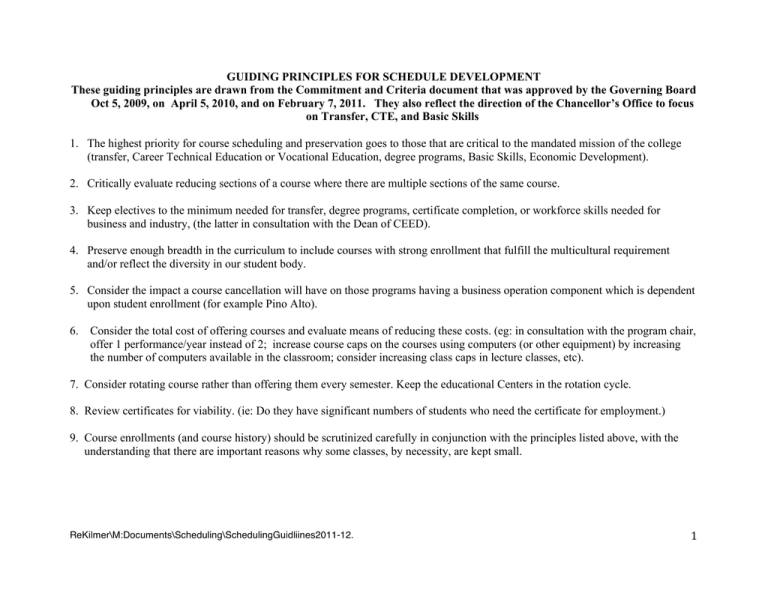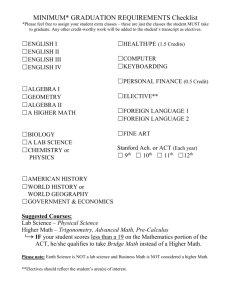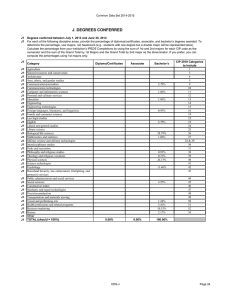GUIDING PRINCIPLES FOR SCHEDULE DEVELOPMENT
advertisement

GUIDING PRINCIPLES FOR SCHEDULE DEVELOPMENT These guiding principles are drawn from the Commitment and Criteria document that was approved by the Governing Board Oct 5, 2009, on April 5, 2010, and on February 7, 2011. They also reflect the direction of the Chancellor’s Office to focus on Transfer, CTE, and Basic Skills 1. The highest priority for course scheduling and preservation goes to those that are critical to the mandated mission of the college (transfer, Career Technical Education or Vocational Education, degree programs, Basic Skills, Economic Development). 2. Critically evaluate reducing sections of a course where there are multiple sections of the same course. 3. Keep electives to the minimum needed for transfer, degree programs, certificate completion, or workforce skills needed for business and industry, (the latter in consultation with the Dean of CEED). 4. Preserve enough breadth in the curriculum to include courses with strong enrollment that fulfill the multicultural requirement and/or reflect the diversity in our student body. 5. Consider the impact a course cancellation will have on those programs having a business operation component which is dependent upon student enrollment (for example Pino Alto). 6. Consider the total cost of offering courses and evaluate means of reducing these costs. (eg: in consultation with the program chair, offer 1 performance/year instead of 2; increase course caps on the courses using computers (or other equipment) by increasing the number of computers available in the classroom; consider increasing class caps in lecture classes, etc). 7. Consider rotating course rather than offering them every semester. Keep the educational Centers in the rotation cycle. 8. Review certificates for viability. (ie: Do they have significant numbers of students who need the certificate for employment.) 9. Course enrollments (and course history) should be scrutinized carefully in conjunction with the principles listed above, with the understanding that there are important reasons why some classes, by necessity, are kept small. ReKilmer\M:Documents\Scheduling\SchedulingGuidliines2011-12. 1 Other considerations: 1. Reduce course repetitions in disciplines often repeated for enrichment: consider limiting repetitions in, Art, Music, and certain CTE areas. This will require a change to curriculum. 2. Traditionally, noncredit courses have had no limits on repeatability. Review noncredit courses and establish limits, where appropriate. 3. All chairs and deans should become familiar with the certificates and majors they supervise so that they can distinguish between a required course and restricted electives (a restricted elective allows students to pick a class from a list of choices). It is more critical to preserve required courses than restricted electives. 4. Review courses that havenʼt been active for a long time and inactivate them. 5. When cohort groups exist, consider reducing the number of cohorts, but maintaining the program. Definition of recreational, avocational, and personal development courses: Recreational, avocational, and personal development courses are those which: 1. Are not required courses or restricted electives leading to the completion of the requirements of certificates/majors offered by the college; 2. Are offered primarily to provide recreational or avocational pursuits for students; 3. Are of greater private than public interest; 4. Should be offered as a community service class for a fee that covers the cost of instruction; or 5. Enroll primarily community members seeking enrichment, even if degree applicable and/or transferrable (may depend on time slots). Communication and notifications of significant changes to course offerings: 1. Identify process to communicate with counselors and students so that education plans can be adjusted to meet changes in couser availability 2. Upload changes to department webpages for students 3. Create a statement for the college catalog regarding course offerings and substitutions for majors if reductions have resulted in minimal course offerings for a particular degree (eg: course rotating once every two years instead of once a year). ReKilmer\M:Documents\Scheduling\SchedulingGuidliines2011-12. 2



